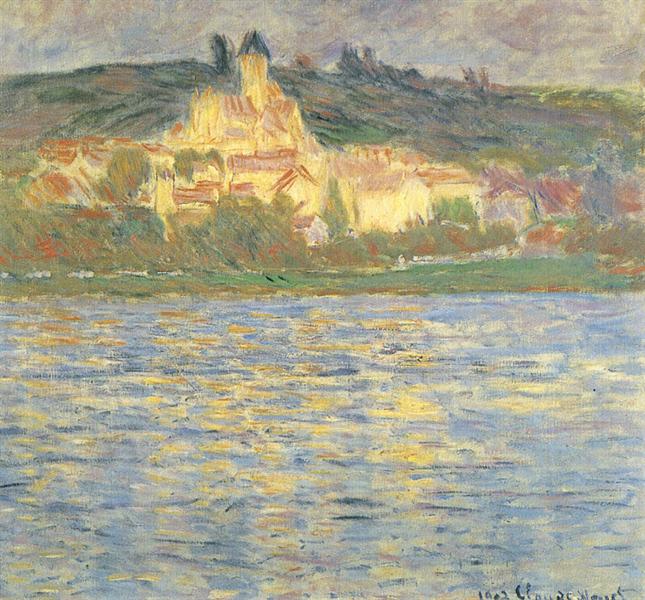Description
Claude Monet's painting "Vétheuil" (1901) is a magnificent testament to the mastery of Impressionism, a movement that Monet helped define. This work is set in the context of his fascination with the light, color and atmosphere of natural landscapes, characteristics that are palpable in his interpretation of the town of Vétheuil, located on the banks of the River Seine. In this work, the artist captures with remarkable virtuosity the calm and contemplative essence of the wind caressing the surface of the water, and the play of light reflected on it.
The composition of "Vétheuil" is characterized by a horizontal layout that evokes the serenity of the landscape. In the foreground, the gentle ripples of the river flow towards the viewer, while the depiction of the trees on the bank adds a dimension of depth. Monet uses a range of earthy greens and browns for these natural elements, which contrast harmoniously with the blue of the water and sky. This palette allows the viewer to immerse themselves in an atmosphere of almost ethereal tranquility, a distinctive feature of Monet's work at this time.
The handling of colour in “Vétheuil” is remarkably atmospheric. Monet employs soft tones and an almost abstract approach in his technique of quick, loose brushstrokes. Not only does this bring the water to life through impressionistic reflections, but it also suggests the subtle variation of light throughout the day. Areas where the light hits are illuminated with a golden glow, evoking the warmth of the sun, while other parts are dipped into cooler shadows, creating a perfect harmony in the depiction of the landscape. This masterful use of colour is not just aesthetic; it also conveys the mood of the surroundings, an essential trait in Monet’s landscapes.
As for the characters, the painting lacks prominent human figures, which is a deliberate choice that allows the viewer to focus all their attention on the relationship between the landscape and the light. However, small boats can be glimpsed in the distance, which, although subtle, add an element of activity and life to the painting, suggesting the presence of humanity in this idyllic setting.
Interestingly, Vétheuil was created during a period when Monet was experimenting with the exercise of colour and the capture of instantaneous sensations, something that distinguishes him from other artists of his time. The work is a perfect example of how his creative process evolved, particularly in the way he devoted himself to observing his surroundings, especially his garden and the surrounding landscapes. Monet was deeply influenced by the changing light of the moment and the atmosphere, aspects that are reflected in the visual complexity of this piece.
With “Vétheuil,” Monet pushes the boundaries of landscape art. Rather than simply depicting a place, he captures the ephemeral nature of the human endeavor to understand and celebrate its ever-changing surroundings. This work is not only a portrait of a place, but a testament to the emotional connection Monet felt toward nature. Through his fluid brushstrokes and well-balanced palette, Monet invites us to experience the beauty of the world he perceived, leaving us in a reflective state that is critical to appreciating his artistic legacy. Thus, “Vétheuil” not only represents a physical space, but also a moment in which art and nature meet in a timeless dance.
KUADROS ©, a famous painting on your wall.
Hand-made oil painting reproductions, with the quality of professional artists and the distinctive seal of KUADROS ©.
Painting reproduction service with satisfaction guarantee. If you are not completely satisfied with the replica of your painting, we will refund 100% of your money.

